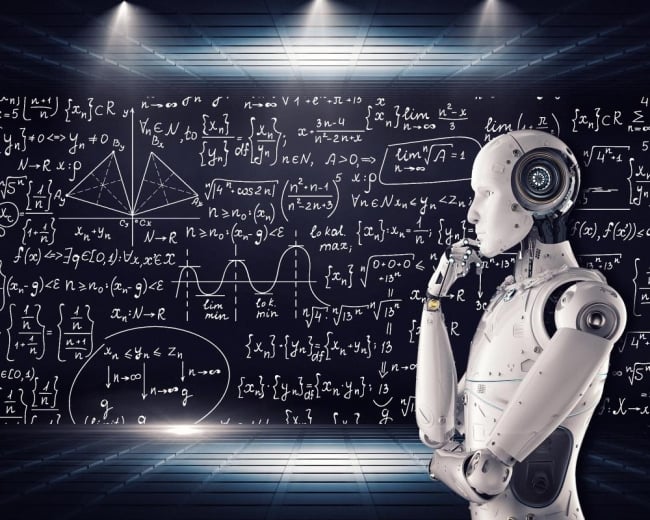You have /5 articles left.
Sign up for a free account or log in.

The dearth of AI professors at U.S. universities is not the result of a distorted job market, according to a recent report.
Mikemacmarketing/Wikimedia Commons
When the ride-hailing company Uber sought to establish a new facility in Pittsburgh in 2015 focused on self-driving cars, it looked to the researchers and scientists at the nearby Carnegie Mellon University robotics center. Soon after, the company lured away 40 of the center’s employees, including the director, with doubled salaries and bonuses in the hundreds of thousands.
High-profile stories like these have contributed to a prevailing narrative that artificial intelligence experts leave academe for industry in droves. But the dearth of AI professors at U.S. universities is not the result of a distorted job market, according to a report issued this month from the Center for Security and Emerging Technology. Rather, AI experts remain interested in academic careers, but university hiring of AI faculty has not kept pace with student demand. Though big tech has stepped in to fill some of the gap, some experts urge caution given that the industry’s incentive structure differs from that of academe.
Historically, academe has delivered a steady stream of developers, engineers and entrepreneurs that has fueled an AI innovation ecosystem. This stream has been directly correlated with AI faculty teaching capacity. But while student enrollment in computer science programs has skyrocketed in the past decade, universities have not hired enough computer science faculty to meet that demand. (The researchers used student demand for computer science as a proxy for student demand in AI, as the latter is difficult to quantify.)
In an apparent response to increased student demand, universities have restricted access to AI programs by limiting enrollment in high-demand classes, reducing the number of small-enrollment classes and tightening computer science admission requirements, according to Jack Corrigan, one of the report’s authors. At the same time, burgeoning numbers of computer science Ph.D. recipients have expressed interest in academic careers, but universities have not responded with a commensurate increase in faculty positions. Contrary to the prevailing narrative that industry poaching of computer science faculty is rampant, universities generally succeed when they seek to hire AI faculty.
Technology companies, for their part, have stepped in to pick up some of the student demand by offering alternative pathways to AI education and training.
“Tech companies are becoming the new ‘cauldrons of innovation’ and functional universities where innovation occurs,” said John Nosta, Google Health Advisory Board member and World Health Organization founding member of the digital health expert roster. Nosta noted that Google, for example, does not always require prospective employees to have earned bachelor of science degrees. “The excitement is no longer coming from the universities, but from innovative companies driving transformation like SpaceX, Amazon, Apple, OpenAI and other for-profit businesses that are leaving a traditional education model in the dust,” Nosta said. His view is that the trend is especially noteworthy in artificial intelligence.
Google is not the only company to have responded to the AI workforce shortage by removing the college degree requirement for some positions. IBM and Apple have also dropped the requirement, an effort they also expect may diversify the talent pool by providing access to those who did not have as many early-life opportunities.
“The jobs are there, and there’s one structural barrier we can remove,” former IBM Corporation chief executive Virginia Rometty told The Wall Street Journal last year. In place of a degree, she said IBM screens for a “propensity to learn” and provides training. The results? The “new-collar employees”—her term for those without a four-year degree—performed at a level that was equal or better than their college-educated co-workers.
Not everyone agrees that industry is the proper training ground for AI experts.
“I’d be loath to call the tech companies ‘universities,’” said Dan Rockmore, a computer science professor at Dartmouth College. “They are really only interested in a targeted set of skills—hardly universal ones—but I do think they are becoming a new kind of focused technical school.”
Rockmore agreed that university AI curricula do not always address marketplace needs but cautioned against relying on tech companies for AI education.
“This will be a narrowly trained group of workers whose products will have extraordinary ramifications on the ways we interact and are governed,” he said. “They build technocratic ‘solutions’ without the perspective of a broad education or possibly a broad and thoughtful outlook on the implications of the work.”
Others point to the historic interplay between higher education and the tech industry. Consider, for example, the field of computer graphics, suggested Cherri Pancake, an Oregon State University computer science professor and former Association for Computing Machinery (ACM) president.
“Nowadays, the vast majority of graphics practitioners are not specialists, though their work still relies on a core of specialists at universities and companies to keep driving the field forward.” Likewise, she noted that artificial intelligence, and specifically machine learning—a high-demand subfield of AI industry—is no different. Academics worked for decades to achieve cost-effective machine learning. “Now, everyone is crying out for that specialty, but the real need is for people who can apply [machine learning] in practical settings,” Pancake said.
She noted that this necessitates a different kind of education—one focused on safe use. “Universities now recognize this need, but it takes time to establish new curricula,” she said.
Some are frustrated by academe’s slow pace. For example, the Seattle Times editorial board penned an op-ed last month in which the editors lamented that colleges and universities in Washington—home of Microsoft headquarters—are “awarding computer-related degrees at less than half the rate the state’s tech companies are adding new positions—let alone filling openings for existing jobs.” They blamed not the students, who are interested in undergraduate computer science programs and technology careers, but the paucity of accessible training programs at the state’s universities. More than 7,500 incoming University of Washington first-year students applied for admission to the computer science and engineering school, they noted, but enrollment limitations likely mean that only 550 new undergraduates will enter in a given year.
Educating the next generation of AI scientists in the U.S. and beyond also weighs on the mind of Jim Hendler, director of the Institute for Data, Artificial Intelligence, and Computation at Rensselaer Polytechnic Institute and chair of the ACM global technology policy council.
“ACM is seeing this issue arising not just in the U.S., but around the world,” he said. “Our curriculum committees are looking at not just college education, but whether some of these gaps could be filled by new programs in K-12 and particularly high school/precollege educational programs.”
While Corrigan acknowledged that industry has a role to play in developing AI talent, he advises policy makers and academic leaders to think critically about the role that universities play.
“The incentive structure for private companies is much different than the incentive structure for universities … If we want to develop the tech workforce in an equitable, just and socially optimal way, we should consider the incentives that are driving the behaviors of each of those actors.”








